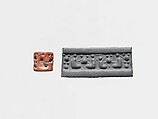Cylinder seal and modern impression: seated "pigtailed ladies" and pots
Not on view
Although engraved stones had been used as early as the seventh millennium B.C. to stamp impressions in clay, the invention in the fourth millennium B.C. of carved cylinders that could be rolled over clay allowed the development of more complex seal designs. These cylinder seals, first used in Mesopotamia, served as a mark of ownership or identification. Seals were either impressed on lumps of clay that were used to close jars, doors, and baskets, or they were rolled onto clay tablets that recorded information about commercial or legal transactions. The seals were often made of precious stones. Protective properties may have been ascribed to both the material itself and the carved designs. Seals are important to the study of ancient Near Eastern art because many examples survive from every period and can, therefore, help to define chronological phases. Often preserving imagery no longer extant in any other medium, they serve as a visual chronicle of style and iconography.
The modern impression of the seal is shown so that the entire design can be seen. The imagery on this seal depicts two pairs of so-called pigtailed ladies, seated facing each other, with arms outstretched towards an object or objects that consist only of a large circular drill mark with two smaller circles above. These three circles may be an abstract representation of the vessels with loop handles frequently seen on other seals of this type. Faint lines below the seated figures suggest mats or cushions. Between the backs of two of the figures are six drill holes, possibly representing two stacked vessels of the same type shown here between the seated figures.
Due to rights restrictions, this image cannot be enlarged, viewed at full screen, or downloaded.


